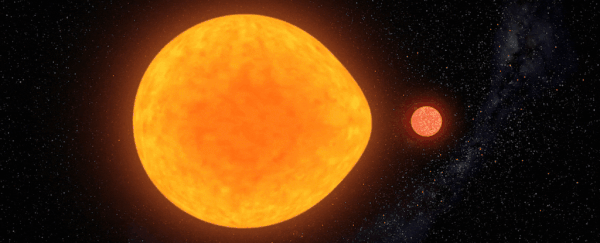The Universe has yielded another surprise, and this time, it's practically under our very noses. Just 1,500 light-years away, astronomers have found a star that pulsates - but only on one side. Although such an object was predicted decades ago, this is the first time we've actually seen it.
"We've known theoretically that stars like this should exist since the 1980s," said astronomer Don Kurtz of the University of Central Lancashire in the UK.
"I've been looking for a star like this for nearly 40 years and now we have finally found one."
The star is called HD74423, an A-type main-sequence star about 1.7 times the mass of the Sun, and younger, too (although it's hard to age it precisely).
Its strange pulsing behaviour was first spotted by citizen scientists poring over data from NASA's exoplanet-hunting space telescope TESS, looking for anomalies.
Unsure of what they were seeing, they took their findings to professional astronomers, ultimately looping in Kurtz and astronomer Gerald Handler of the Nicolaus Copernicus Astronomical Centre in Poland.
Pulsations within a star aren't unusual. Many stars - maybe even all stars - oscillate in rhythmic patterns, caused by waves bouncing around inside the star. These waves are thought to be created by convection and the star's magnetic field; like earthquakes can be used to probe Earth's guts, the waves can reveal what's going on in stellar interiors.
But in all other stars prior to HD74423, these oscillations could be detected globally; that is, over the entire surface of the star. So why is HD74423 such a weirdo?
Well, it has a friend. A really close friend. The pulsating star's binary companion is a red dwarf, and the two are locked in a super-tight orbit of just 1.6 days. At that proximity, the gravity of the red dwarf is distorting HD74423, pulling it into more of an egg or teardrop shape.
And it's not just HD74423's material that's being pulled askew. The red dwarf companion is also distorting the larger star's oscillations. This is what causes the strange behaviour.
"As the binary stars orbit each other, we see different parts of the pulsating star," said astronomer David Jones of the Instituto de Astrofisica de Canarias in Spain. "Sometimes we see the side that points towards the companion star, and sometimes we see the outer face."
But that's not the only thing weird about HD74423. As researchers started examining the object more closely, astronomer Simon Murphy of the University of Sydney in Australia was noticing some unusual chemical abundances.
"What first caught my attention was the fact it was a chemically strange star," Murphy said. "Stars like this are usually fairly rich with metals - but this is metal poor, making it a rare type of hot star."
Low metallicity is one of the defining characteristics of really old stars, but HD74423 is different. It's a type of chemically peculiar object known as a Lambda Boötis star, and its low metallicity is thought to be the result of the star slurping up metal-depleted gas from its immediate environment.
This has absolutely nothing to do with the star's lopsided oscillations. It's a total coincidence. But a really happy one, with the ultimate result being a more complete profile of a star that's just a total oddball in multiple ways.
"We have a very collegial agreement, as stellar astronomers working on TESS data, that we share our results within our working community before submitting them to the journal," Murphy told ScienceAlert.
"That's when the two groups realised they were working on the same star, and we joined forces. That's a rare working arrangement, even in academia, and it is paying dividends for us."
Now that we know what to look for, astronomers think we'll find many more lopsided stars out there, hiding in plain sight.
The reason the star's idiosyncrasies hadn't been noticed before now is because of the available tools. TESS is staring at much larger regions of the sky, collecting data on hundreds of thousands of stars.
In addition, citizen science is larger than ever - human eyes, after all, are much better at noticing discrepancies and blips in data than AI is. There are currently over 16,000 volunteers combing through TESS observations looking for planets and other unusual events (you can join in here if you're interested). It's very much a numbers game.
"When you have a revolution in data quality like this, you often observe new phenomena," Murphy said. "We might find many more of these stars with tidally trapped pulsations, but they're still pretty rare. It's just the case that if you observe hundreds of thousands of stars, you can find super rare objects occasionally."
Now that astronomers know what a star like this looks like in the data, they can apply that knowledge to searching through the archives for more.
Meanwhile, astronomers are continuing to work on HD74423. They are still collecting observations, and working on mathematically describing how the binary system behaves.
The research has been published in Nature Astronomy.
